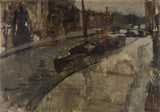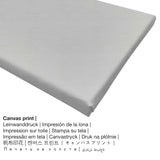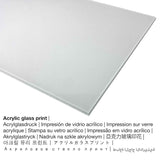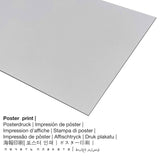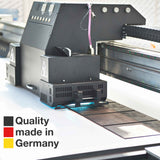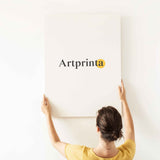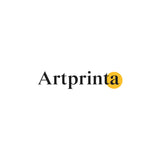George Hendrik Breitner, 1880 - Ọwa mmiri Prinsengracht dị nso na Laurier, Amsterdam - mbipụta nka mara mma.
Ụtụ gụnyere. Mbupu gbakọrọ na ndenye ọpụpụ.
Overview
In 1880 George Hendrik Breitner painted this work of art named "Prinsengracht Canal near Laurier, Amsterdam". Taa, ọrụ nka a nwere ike ile anya na Rijksmuseum's digital art collection in Amsterdam, Netherlands. The nkà nke oge a ngalaba ọha A na-etinye ihe osise na nkwanye ùgwù nke Rijksmuseum.Additionally, the work of art has the following creditline: . On top of that, alignment is in landscape format and has an image ratio of 1.4 : 1, which implies that ogologo bụ 40% ogologo karịa obosara. The photographer, painter George Hendrik Breitner was a European artist from the Netherlands, whose style can be attributed primarily to Impressionism. The artist was born in 1857 and died at the age of 66 na 1923.
(© nwebiisinka - Rijksmuseum - Rijksmuseum)
Amsterdam canal. Study of the Prinsengracht with some ships. Under this study remains of a sketch with Figs.
Ozi ndabere na ọrụ nka mbụ
| Aha ọrụ nka: | "Prinsengracht Canal near Laurier, Amsterdam" |
| Nhazi nka nka: | sere |
| Otu izugbe: | nkà nke oge a |
| Narị afọ nka: | 19th narị afọ |
| Afọ nka: | 1880 |
| Afọ nka: | gbara afọ 140 |
| Ụlọ ihe ngosi nka / ebe: | Rijksmuseum |
| Ebe ebe ngosi nka: | Amsterdam, Netherlands |
| Weebụsaịtị ihe ngosi nka: | Rijksmuseum |
| License: | ngalaba ọha |
| Site n'aka: | Rijksmuseum |
Onye na-ese ihe
| Aha onye nka: | George Hendrik Breitner |
| Aha ndị ọzọ: | Breitner Georges H., Breitner Georg Hendrik, Breitner G. H., Breitner George Hendrik, Breitner, ברייטנר ג'ורג' הנדריק, George Hendrik Breitner |
| Gender: | nwoke |
| Obodo onye nka: | Dutch |
| Ọrụ: | ese foto, ese foto |
| Obodo obibi: | mba netherland |
| nhazi ọkwa: | omenkà nke oge a |
| styles: | Mmetụta |
| Akwụsị: | 66 afọ |
| Afọ ọmụmụ: | 1857 |
| Afọ nwụrụ: | 1923 |
Họrọ ngwa ngwaahịa ọkacha mmasị gị
Maka ngwaahịa ọ bụla anyị na-enye ihe dị iche iche & nha. Anyị na-ahapụ gị ka ịhọrọ n'ime ụdị ndị a:
- Mbipụta enyo acrylic: An acrylic glass print, often referred to as a print on plexiglass, will turn the original into décor. Additionally, it offers a good alternative to canvas and dibond fine art prints. The work of art is made thanks to state-of-the-art UV print technology. With an acrylic glass fine art print sharp contrasts and details become exposed because of the delicate tonal gradation of the print. Our acrylic glass protects your chosen fine art print against light and external influences for many more years.
- Metal (aluminium debond mbipụta): An Aluminium Dibond print is a material with an outstanding effect of depth. The Aluminium Dibond Print is your best start to art prints on aluminum. For our Print On Aluminum Dibond, we print your chosen work of art onto the aluminium white-primed surface. The white & bright components of the artpiece shine with a silk gloss, however without glare. Colors are bright and luminous in the highest definition, details of the print appear crisp. This direct UV print on aluminium is the most popular entry-level product and is an extremely sophisticated way to display fine art reproductions, because it draws focus on the whole artwork.
- Akwụkwọ mmado na ihe kwaaji: The poster print is a printed canvas with a slight surface texture. The poster print is qualified for framing the fine art print using a special frame. Please bear in mind, that depending on the absolute size of the canvas poster print we add a white margin between 2-6cm round about the work of art in order to facilitate the framing.
- Mbipụta kanvas: A printed canvas material mounted on a wooden frame. A printed canvas of this work of art will give you the chance of transforming your fine art print into a large work of art like you would see in a gallery. Hanging a canvas print: Canvas prints are relatively low in weight, which means that it is quite simple to hang up the Canvas print without additional wall-mounts. Therefore, canvas prints are suited for all types of walls.
Nkọwa edemede
| Nkewa edemede: | ezi nka mmeputakwa |
| Usoro mmeghari: | dijitalụ mmeputakwa |
| Usoro nhazi: | Mbipụta UV ozugbo (mbipụta dijitalụ) |
| Nlụpụta: | Germany |
| Stockdị ngwaahịa: | na mmepụta ihe |
| Ngwaahịa were: | nchịkọta nka (mmeputakwa), mma mgbidi |
| Ndepụta: | usoro odida obodo |
| Oke akụkụ: | 1.4: 1 ogologo: obosara |
| Ihe: | ogologo bụ 40% ogologo karịa obosara |
| Akụrụngwa ị nwere ike ịhọrọ: | ígwè obibi akwụkwọ (aluminium dibond), akwụkwọ mmado (akwụkwọ kwaaji), mbipụta enyo acrylic (nke nwere ezigbo mkpuchi iko), mbipụta akwụkwọ. |
| Mbipụta kanvas (akwa akwa na etiti ihe ndọtị) dị iche iche: | 70x50cm - 28x20", 140x100cm - 55x39" |
| Mpempe iko acrylic (nwere ezigbo mkpuchi iko) nha dị iche iche: | 70x50cm - 28x20", 140x100cm - 55x39" |
| Nhọrọ nha nke akwụkwọ mmado (akwụkwọ kwaaji): | 70x50cm - 28x20" |
| Mbipụta aluminom: | 70x50cm - 28x20", 140x100cm - 55x39" |
| ụba: | adịghị |
Legal disclaimer: We try what we can to describe our products as closely as we can and to exhibit them visually in our shop. However, the pigments of the printing material and the printing may vary to a certain extent from the presentation on the screen. Depending on your settings of your screen and the quality of the surface, not all colors can be printed as realistically as the digital version. Because all art reproductions are processed and printed by hand, there might also be minor discrepancies in the exact position and the size of the motif.
© Nwebiisinka nke | Artprinta (www.artprinta.com)

